

Speyside Whisky festival and tour in the North-East of Scotland 26th Sept- 02 Oct. 2007
Speyside and Highlands tour 2007
Part 1, 2, 3, photo gallery
Part 2:
My third day was not quieter than the first days, but since all the events I attended during that day were part of the Speyside whisky festival, I did not have to drive and could enjoy the landscape! My first event was the Glen Garioch and Ardmore distillery tour. The first stop was as the Glen Garioch distillery, a distillery that I had had the pleasure to visit the year before. The tour started with a visit of the old floor malting. Interestingly, Glen Garioch made a small scale production of malted barley on their floor malting in 2003. For cost reasons this experience was not renewed. It would however, be very interesting to taste this whisky if it will be bottled. The production has increased from 450’000 LPA in 2006 to 540’000 LPA in 2007. Glen Garioch has recently released a new 8 YO Glen Garioch which coincides with the change in the production method of 8 years ago, when the distillery decided to reduce the peatiness of their malted barley. In the new 8 YO, I could not detect any peatiness, as compared to the 15 YO we were served in the old Excise officer’s house. The oldest cask on site is from 2000.
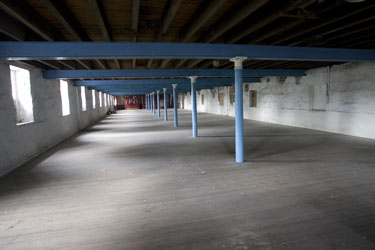 |
| The old floor maltings at Glen Garioch used for the last time in 2003 |
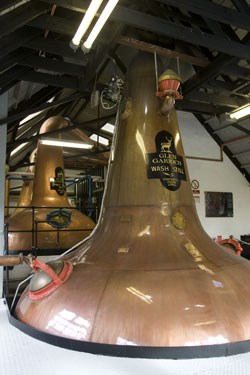 |
| The still house, with the second still not in use. |
Ardmore is the heart and home of Teacher’s whisky. Ardmore is producing two types of malt, one lightly peated (12 ppm) and a heavily peated one (40 ppm). The distillery is rather old fashioned and Ardmore was one of the last distilleries in Scotland to use direct coal fire for their stills until 2001. In the distillery, the old steam engine can be seen, as well as the plate of the old boiler. Despite its old fashioned appearance, the distillery is now producing 5.1 mio LPA in 2007 (4.3 mio LPA in 2006). In the VIP room, we had the pleasure of tasting the Ardmore 12 YO for the centenary of the distillery in 1999, as well as tasting the new Ardmore Traditional cask highland that will be available in duty free next week and on the UK market from Christmas and onwards. An Ardmore 25 YO matured in puncheon will also be released soon.
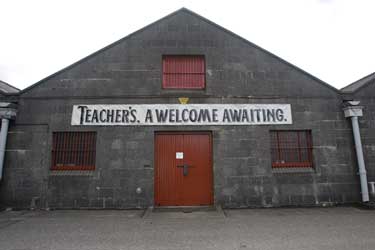 |
| One of the warehouse in Ardmore |
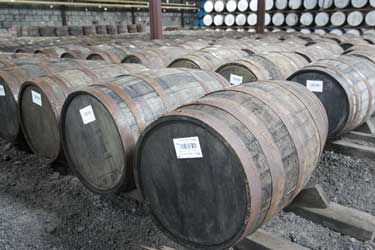 |
| And a display of quarter cask used for the finishing of the new Ardmore traditional cask |
In the afternoon, I participated to the Greencore Port Gordon Crisp Malting tours organized by the Speyside Autumn whisky festival. Our guide was Graham Taylor, the master Malter. These maltings are producing 42’000 tonnes of malted barley per annum and are working at full capacity since a few years back. They are not only producing malted barley for the Speyside distilleries, but also for the Islay distilleries. They are currently working with 4 strains of barley, including two test ones. The actual prices for malted barley are now about £400-420/tonne. Last year, the price was around £240-260, almost the price of unmalted barley. The Port Gordon Maltings are quite different from the Port Ellen maltings on Islay, since all the operations (steeping, germination, and kilning) are produced in vertical vessels while the kilning is performed in rotative kilning vessels, like at the Roseile maltings. The plant was very interesting to visit. Unfortunately, I am not allowed to publish the photographs taken during this tour.
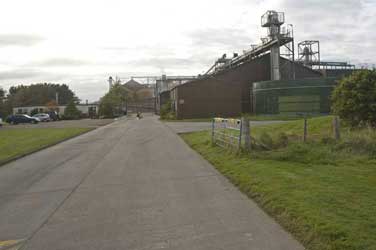 |
| The Port Gordon maltings from the gate. |
On Saturday, my day started with a tour in Keith and to take some exterior photographs of the Strathmill and Glen Keith distillery before taking a tour at the Strathisla distillery. The price was quite expensive (£5) by comparison to the Glenlivet distillery, which is free and part of the same group. Strathisla is a compact distillery and the spiritual home of Chivas regal. Strathisla is one of the few distilleries using 4 waters for mashing. Until 1993, the stills were heated by direct fire I was surprised to hear from the guide that the distillery moved from liquid to solid yeast during the summer. Was this change done for quality reasons or for the yield?
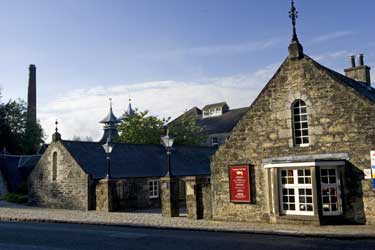 |
| Strathisla distillery |
In the afternoon, I headed to Forres for visiting the Benromach distillery, bought in 1993 by Gordon & Macphail (G&M). Since the premises were empty when G&M bought the distillery, the distillery re-opened only in 1998. The distillery has now a state of the art equipment, including a new set of stills with a shape different to the previous ones. The only oddity is the small and old Boby mill, coming very likely from a brewery. Brewer and distillers yeast is used for the process and 10% of the Benromach production is sold or traded as Glenmosset whisky. The production is now around 200’000 LPA.
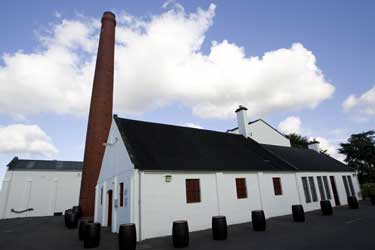 |
| Benromach distillery |
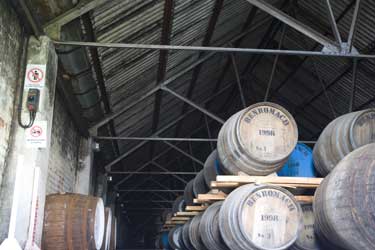 |
| And inside of the warehouse. |
With some time left, I went to Cardhu for the last tour of the day. Cardhu was made famous in 2003, when Diageo switched from Cardhu single malt to Cardhu pure malt, while keeping the same packaging. The story is now over and Cardhu is a single malt. The production at Cardhu is now at 61’500 LPA per week. Since August, the distillery is now running at full capacity and working 7 days a week. Two new stainless washbacks have been installed in addition to the existing Scottish larch and Oregon pine washbacks. In the evening, I enjoyed a few drinks at the Highlander Inn in Craigellachie, with a bar offering a large selection of fine whiskies.
!www.whisky-news.com ©11 October 2007